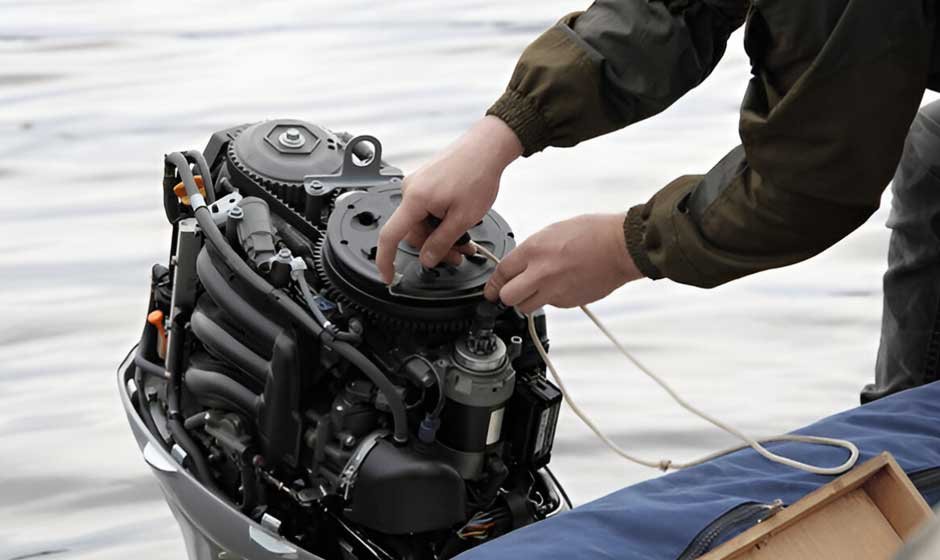There is nothing quite like the freedom of open water, until your outboard motor sputters and dies. As a boater, you know how expensive outboard motors are to buy and repair. But the truth is that most of these breakdowns are preventable. You just have to maintain your outboard properly so you don’t have to deal with the frustration of early wear and tear.
The thrill of a smooth ride in open water is unmatched, but if your outboard motor is not maintained, the experience can be ruined. This is why we are providing you with an outboard motor maintenance checklist for 2025, so your outboard motor lasts longer.
1. Inspect the Engine Before Every Trip
If you haven’t been on the water in a while, you might think it’s in the same condition as when you left it. But inspecting the engine before every trip is essential. Sometimes, your boat’s performance slowly declines due to inadequate maintenance, and you may not even realize it.
iStock/GKV
It is essential to:
- Check for fuel or oil leaks
- Ensure the propeller is free from fishing line or debris
- Verify that fuel lines are soft and not cracked
- Test the kill switch and battery connections
This routine inspection might sound insignificant, but the 5-minute check-up before you leave for the trip saves a full day of frustration afterwards.
2. Flush Your Engine After Every Use
Saltwater causes corrosion buildup on outboards. When you do not flush your engine after every trip, you are unintentionally increasing the chances of your outboard getting corroded.
iStock/adavino
Benefits of flushing your marine motor with fresh water:
- Removes salt, sand, and sediment
- Protects internal cooling passages
- Keeps the water pump impeller functioning
Flushing the engine after every outing ensures optimal performance and prolongs the engine’s life. Remember, flushing isn’t just necessary after running your boat in saltwater; you should also do it after using it in freshwater to remove alkali, dirt, salt, sand, and silt. However, in the case of freshwater use, flushing after every 2–3 outings is usually sufficient.
3. Change the Engine Oil and Filter Regularly
For four-stroke outboard engines, it is essential to perform routine oil changes. If it is not done routinely, it can negatively impact the engine’s performance.
While you change the engine oil, keep the following things in mind:
- Use marine-grade oil
- Replace the oil filter each time
- Follow your manufacturer’s recommended interval (usually every 100 hours or once a season)
If an outboard engine contains too little or contaminated oil, it will wear out and eventually die. This is why changing the engine oil is necessary to ensure the longevity of your boat engine.
4. Replace Spark Plugs & Fuel Filters
If you avoid changing spark plugs and fuel filters, they will wear out and degrade over time. By doing so, you risk the engine backfiring. If it happens, your boat will face combustion and fuel flow issues.
iStock/BanksPhotos
You should consider doing:
- Inspect and replace spark plugs if corroded or fouled
- Install a new in-line fuel filter and water separator
- Add a fuel stabilizer if the boat will sit unused for over 30 days
You should check the spark plugs every 100 hours and replace them if necessary. This interval helps maintain consistent ignition performance, especially if the engine is frequently operated at high RPMs, which can accelerate wear.
5. Check and Lubricate Moving Parts
Regular lubrication of mechanical components is crucial for them to function smoothly. Proper lubrication can prevent wear and tear and early damage to gearcase components.
The right approach for lubricating moving parts:
- Grease the steering mechanism, pivot points, and throttle linkages
- Inspect and refill the lower unit (gearcase) oil
- Watch for signs of water intrusion. If you find milky oil, it is a red flag.
If the moving parts are regularly lubricated, they will perform optimally, resulting in a positive impact on their longevity.
6. Winterize Your Outboard Motor
The cold and freezing weather promotes corrosion and damage to the outboard. In cold conditions, winterizing the outboard is the best option. This approach will store your boat safely during the off-season and prevent unnecessary wear and tear.
The right way to winterize:
- Drain fuel or stabilize it
- Fog the cylinders with storage oil
- Remove the battery and store it in a dry, cool place
- Cover the boat engine with a breathable outboard motor cover to prevent moisture buildup
Winterizing involves several steps, including flushing the cooling system, changing the oil and gear lubricant, stabilizing the fuel, fogging the engine, and greasing moving parts.
7. Schedule Annual Professional Servicing
To ensure the best condition of your outboard motor, regular maintenance alone is not enough. At least once a year, you should schedule a consultation with an expert marine technician.
A marine technician can help you:
- Run diagnostics
- Check engine timing and compression
- Update firmware on newer electronic outboard engines
- Inspect the lower unit for hidden damage
If you are buying used outboard parts or engines in 2025, ensure they have been tested or reconditioned by a reputable marine shop. You can find quality outboard motor parts from trusted suppliers such as OBParts to ensure performance and longevity.
Tools and Supplies You’ll Need to Maintain Outboard Motors
You are considering carrying out the proper maintenance of your outboard motor parts, but what if you dont have the required tools and supplies? Here are some essential resources that you will use: Marine-grade engine oil
- Gear lube
- Grease gun
- Freshwater flushing adapter
- Fuel stabilizer
- Spark plug socket and gap tool
- New gaskets, filters, and an outboard motor maintenance kit
Final Thoughts
The latest boat engines have become very advanced and highly fuel-efficient with time. If small maintenance factors are overlooked, it can cause much bigger issues in the future. Preventive care is the most affordable strategy to cope with costly outcomes that could arise as a result of no maintenance.
Exploring the open water is the best thing you can do in 2025, but make sure your engine is ready for it. By properly following the longevity checklist, you’ll extend your marine engine’s lifespan, ensure better performance, and avoid costly surprises.
So, before your next trip, keep this in mind that your boat deserves a little extra attention to last long.











